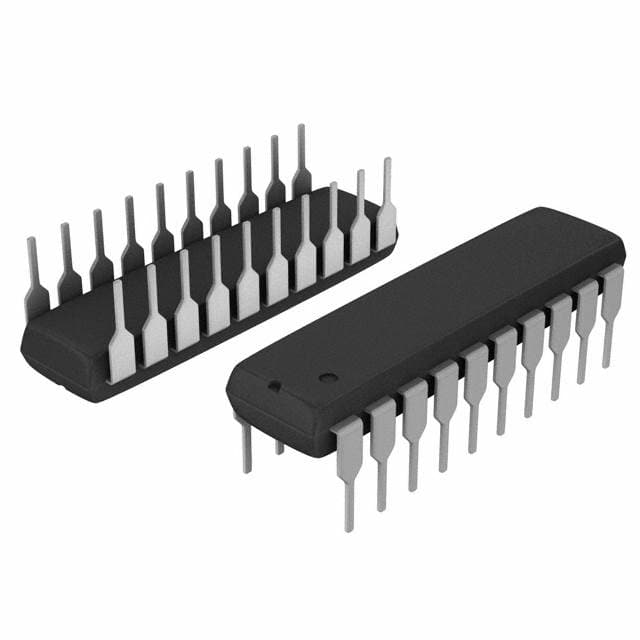N79E822ADG
Basic Information Overview
- Category: Microcontroller
- Use: Embedded systems, IoT devices, consumer electronics
- Characteristics: Low power consumption, high performance, small form factor
- Package: DIP (Dual In-line Package)
- Essence: Integrated circuit for controlling and managing electronic devices
- Packaging/Quantity: Available in reels or trays, quantity varies based on manufacturer's specifications
Specifications
- Architecture: 8-bit
- CPU Speed: Up to 24 MHz
- Flash Memory: 8 KB
- RAM: 1 KB
- Operating Voltage: 2.4V - 5.5V
- I/O Pins: 20
- Communication Interfaces: UART, SPI, I2C
- Timers/Counters: 2 x 8-bit, 1 x 16-bit
- ADC Channels: 8
- PWM Channels: 4
Detailed Pin Configuration
The N79E822ADG microcontroller has a total of 20 pins. The pin configuration is as follows:
| Pin Number | Pin Name | Function | |------------|----------|----------| | 1 | VDD | Power Supply Voltage | | 2 | P0.0 | General Purpose I/O | | 3 | P0.1 | General Purpose I/O | | 4 | P0.2 | General Purpose I/O | | 5 | P0.3 | General Purpose I/O | | 6 | P0.4 | General Purpose I/O | | 7 | P0.5 | General Purpose I/O | | 8 | P0.6 | General Purpose I/O | | 9 | P0.7 | General Purpose I/O | | 10 | RST | Reset | | 11 | P1.0 | General Purpose I/O | | 12 | P1.1 | General Purpose I/O | | 13 | P1.2 | General Purpose I/O | | 14 | P1.3 | General Purpose I/O | | 15 | P1.4 | General Purpose I/O | | 16 | P1.5 | General Purpose I/O | | 17 | P1.6 | General Purpose I/O | | 18 | P1.7 | General Purpose I/O | | 19 | XTAL1 | Crystal Oscillator Input | | 20 | XTAL2 | Crystal Oscillator Output |
Functional Features
- Low power consumption enables longer battery life in portable devices.
- High-performance CPU allows for efficient execution of complex tasks.
- Small form factor makes it suitable for space-constrained applications.
- Multiple communication interfaces facilitate connectivity with other devices.
- Timers and counters provide precise timing control.
- ADC channels enable analog signal acquisition.
- PWM channels allow for accurate control of motor speed or LED brightness.
Advantages and Disadvantages
Advantages: - Low power consumption extends battery life. - High-performance CPU enables efficient processing. - Small form factor allows for integration into compact designs. - Versatile communication interfaces enhance connectivity options. - Timers, counters, ADC, and PWM channels offer flexibility in application development.
Disadvantages: - Limited flash memory and RAM may restrict the complexity of applications. - 8-bit architecture may not be suitable for computationally intensive tasks. - Limited I/O pins may require additional external components for larger projects.
Working Principles
The N79E822ADG microcontroller operates based on an 8-bit architecture. It executes instructions stored in its flash memory and utilizes the on-chip RAM for temporary data storage. The CPU fetches instructions from memory, decodes them, and performs the necessary operations. It interacts with external devices through various communication interfaces, such as UART, SPI, and I2C. The microcontroller's timers, counters, ADC, and PWM channels provide additional functionality for precise timing control, analog signal acquisition, and pulse width modulation.
Detailed Application Field Plans
The N79E822ADG microcontroller finds applications in various fields, including: 1. Embedded Systems: Used in industrial automation, smart home systems, and robotics. 2. IoT Devices: Enables connectivity and control in IoT applications like smart agriculture, environmental monitoring, and asset tracking. 3. Consumer Electronics: Powers devices such as remote controls, electronic toys, and wearable devices. 4. Automotive: Used in automotive electronics for controlling functions like lighting, motor control, and dashboard displays. 5. Medical Devices: Provides control and monitoring capabilities in medical equipment like patient monitors and infusion pumps.
Detailed and Complete Alternative Models
- N76E003AT20: 8-bit microcontroller with similar features but lower
기술 솔루션에 N79E822ADG 적용과 관련된 10가지 일반적인 질문과 답변을 나열하세요.
Sure! Here are 10 common questions and answers related to the application of N79E822ADG in technical solutions:
Q: What is N79E822ADG? A: N79E822ADG is a microcontroller from Nuvoton Technology, suitable for various technical applications.
Q: What are the key features of N79E822ADG? A: Some key features include an 8-bit CPU, 18KB flash memory, 768 bytes of RAM, multiple communication interfaces, and various peripherals.
Q: What technical solutions can N79E822ADG be used for? A: N79E822ADG can be used in applications such as home automation, industrial control systems, consumer electronics, and automotive electronics.
Q: How can I program N79E822ADG? A: N79E822ADG can be programmed using the Nuvoton development environment or third-party tools that support the Nuvoton microcontroller series.
Q: What programming languages are supported by N79E822ADG? A: N79E822ADG supports assembly language and C programming.
Q: Can N79E822ADG communicate with other devices? A: Yes, N79E822ADG has multiple communication interfaces such as UART, SPI, and I2C, allowing it to communicate with other devices.
Q: Does N79E822ADG have analog-to-digital conversion capabilities? A: Yes, N79E822ADG has built-in ADC channels, enabling it to convert analog signals into digital values.
Q: Can N79E822ADG operate on low power? A: Yes, N79E822ADG has power-saving modes and features that allow it to operate on low power, making it suitable for battery-powered applications.
Q: Is N79E822ADG suitable for real-time applications? A: Yes, N79E822ADG has a built-in hardware watchdog timer and interrupt capabilities, making it suitable for real-time applications.
Q: Where can I find technical documentation and support for N79E822ADG? A: You can find technical documentation, datasheets, application notes, and support resources on the Nuvoton Technology website or contact their customer support for assistance.
Please note that these answers are general and may vary depending on the specific requirements and use cases of your technical solution.


